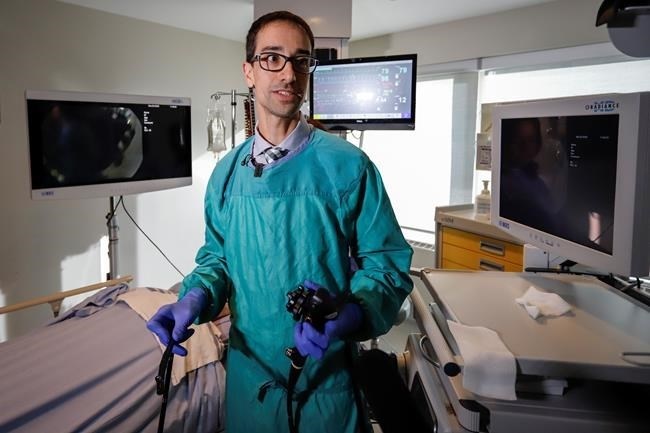
Dr. Paul Belletrutti, speaks to the media about how patients undergoing surgery for early-stage stomach and intestinal cancer are recovering faster and going home sooner as a result of a new surgical approach in Calgary, Alta., Tuesday, March 3, 2020.
Image Credit: THE CANADIAN PRESS/Jeff McIntosh
March 04, 2020 - 5:00 AM
CALGARY - Doctors say patients undergoing surgery for early-stage stomach and intestinal cancer in Calgary are recovering faster and going home sooner because of a new surgical approach.
The Peter Lougheed Centre is the first on the Prairies to adopt the minimally invasive method for removing cancerous tissue from the gastro-intestinal tract. The treatment, which is already being performed in Canada's other major cities, reduces the need for removing parts of the stomach or intestines.
Doctors insert an endoscope, which is a tube with a small video camera, through the mouth or anus, and guide small tools through the endoscope tube to remove cancerous tissue.
"It's basically a bright light, with a high definition video camera on a flexible tube. This is what you'd use for a colonoscopy — so with this procedure we're doing an operation through this instrument," explained Dr. Paul Belletrutti, a gastroenterologist who performs the procedure.
"Here we're actually working without any incisions so we're basically going through the mouth or through the back end, and all of the operation is done through instruments inserted through the channel of the scope."
It then visualizes and removes cancerous tissue from the esophagus, stomach, small intestine or rectum.
Patients can be discharged within 24 hours, unlike other surgeries which could keep them in hospital for several days.
"Traditionally if we had an early cancer in the GI (gastrointestinal) tract you'd have to have a formal operation where you'd go into the operating room, make a series of incisions, and either go through the abdominal cavity or the chest cavity to access the area. Then you'd have to cut out an entire section of the GI tract," explained Belletrutti.
"This way if there's a very early cancer we don't have to take as much tissue or any of the organ out. We have no skin incision — that means much less pain, a very fast recovery, very minimal time in hospital and then a quicker return to activities and work."
The procedure was originally developed in Japan, and has been done for a couple of years in Toronto and Montreal while Vancouver adopted it about a year ago, Dr. Belletrutti said. It's also being performed in Kingston, London and Ottawa.
The Calgary team, comprised of gastroenterologists, endoscopic surgeons, and pathologists, has successfully treated eight patients with three more to undergo the procedure this month.
There are plans to formally introduce the procedure in Edmonton later this year.
Andy Blundell, 68, was the first patient to have the surgery in Calgary.
He said doctors found cancerous tumors in his esophagus three years ago. The options then were to wait and see how the cancer progressed or to undergo an operation that would include seven hours on the operating table, two weeks in the hospital and a year to recover.
"That's the best case and it would have been very risky surgery because the tumors were located between my heart and my backbone and between the two sides of my windpipe," Blundell said.
"Very fortunately for me the technology developed more quickly than my tumors did so it was obviously a no-brainer when I had the third option, which was much less risk, much less recovery."
Blundell said he had a surgery in December and the experience wasn't bad at all.
"I went in at seven o'clock in the morning, was home by lunch time, could eat soft foods and the following afternoon I was out playing snooker with my buddy."
Cancer of the gastrointestinal tract affects abut 6,000 Albertans per year.
This report by The Canadian Press was first published March 3, 2020
Follow @BillGraveland on Twitter
News from © The Canadian Press, 2020